Japanese Painting - one of the most ancient directions in art. Painting in Japan appeared in the most ancient period History of the country. On pottery and other household items, you can find the simplest images of geometric shapes and various patterns. However, with the arrival of the country chinese cultureThe works of Japanese artists more and more began to contain elements of the painting of the country of Confucius.
One of the most impressive and colorful directions of Japanese painting is the landscape. Japanese artists did not attach a special value of the realistic composition of the composition. The main thing for them was the transfer of impressions from contemplated by them majestations of nature.
How to draw a picture in Japanese style?
Japanese landscape can be depicted by ordinary watercolor paints. To practice, it is necessary to use more water, and more paint add more paint to draw individual parts.
In order to start work, you will need cardboard or watercolor paper, simple pencil, eraser, pastel chalk and, of course, watercolor.

- Start with a pencil sketch. For this picture contours Future picture on a sheet with a simple pencil. Make sure that the lines were very soft and barely noticeable. Press the pencil is needed quite slightly. After all, in the Japanese tradition, the drawing should be very light and almost weightless. In no case do not draw parts with a pencil - this is the concern of a thin brush.
- Portage in the background distant mountains, pagodas, reservoirs, build several traditional Japanese bridges.
- At the outline of the silhouettes of people do not forget to take into account the features of their clothes and posture.
- For paintings in the Japanese spirit already became the usual presence on them the main symbol of this country - blooming sakura. You can also portray this amazing cherry in the beauty with the petals flying in the wind.

- After applying a pencil sketch get painting Pictures. remember, that colors must be weightless, air. To do this, it is necessary to choose the right ratio of water and paint. It is necessary to take into account the ability of cardboard to absorb water, and watercolors to the appearance of flops.
- For dyeing background (for example, sky and water) use thick brushes. Start this process with large parts that are at the top of the picture, gradually descend down until you paint all the water, greens and sky parts in the picture. Then leave the drawing until complete drying.
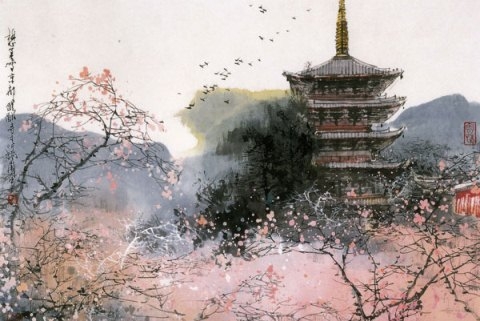
- Now you can go to detail.Take a thin brush and start drawing crowns and trunks of trees, roofs of houses, snowy vertices of mountains. Do not try to draw each item right up to leaves and petals. Your task is to set the direction of buds and branches using several brush strokes. To get the necessary shades, watercolor mix on the palette. It is worth avoiding too obvious, bright shades.
- In one of the corners of the picture lay out japanese hieroglyphs. On the Internet you can find many suitable Japanese poems for you (hockey). These characters do not draw as simple as it seems at first glance, so in their image it is better to practice. To give the letters of a light prescription and some dusting, use black paint, mixed with blue or brown.
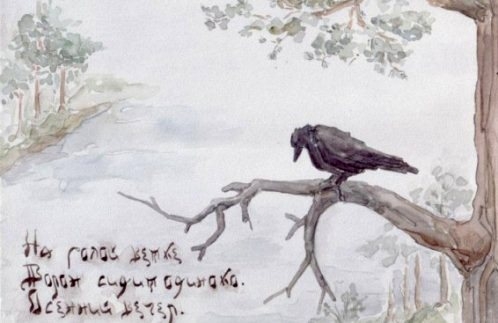
- Using pastel crayons, create shadows. They must be located on the slopes of the mountains and the surface of the water. The main thing is not to overdo it. They should not be too much.
Simple painting in Japanese style
If you do not have a lot of time, and the desire to draw extensive landscapes is not so much, but I would like to decorate the interior of the Japanese "patch", you can use the following method. Draw a thick black paint tree branch. Then in a disposable plate pour a bit of gentle-pink paint. In the paint dip the bottom plastic bottle And make prints on paper. Wait until the drawing is driving. Thus, you will get a wonderful branch of Sakura, without applying your own efforts.
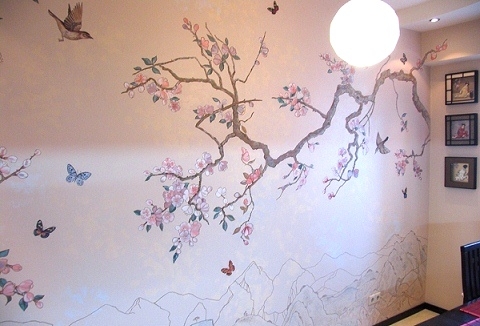
Today, the Japanese topics in the interior is very relevant. These are paintings, and wall decor, and
Japanese painting is an absolutely unique direction in global art. It exists since ancient times, but as a tradition has not lost its popularity and the ability to amaze.
Attentiveness to traditions
East is not only landscapes, mountains and ascending sun. These are also the people who created his story. It is such people that support the tradition of Japanese painting for many centuries, developing and attracting their art. Those who made a considerable contribution to the history of Japanese artists. Modern precisely thanks to them retained all the canons of traditional Japanese painting.
Master of drawing picture
Unlike Europe, Japanese artists preferred to write closer to the chart than to painting. In such pictures, do not find coarse, careless smears of oil, which are so characteristic of impressionists. What is the graphic of such art, like Japanese trees, rocks, animals and birds - everything in these paintings is drawn as clear as possible, solid and confident lines of carcass. All items in the composition necessarily there is a contour. Pouring inside the contour is usually performed by watercolor. The color is blurred, other shades are added, and somewhere leave the paper color. Decorativeness - exactly what distinguishes japanese paintings From the art of the whole world.
Contrasts in painting
Contrast is another characteristic reception that Japanese artists use. It may be the difference in tone, color or contrast of warm and cold shades.
The artist resorts to the reception when he wants to select some element of the subject. It can be a straw on a plant, a separate petal or tree trunk against the sky. Then the bright, illuminated part of the subject and shadow under it (or vice versa) is depicted.
Transitions and color solutions
Drawing Japanese paintings, often use transitions. They are different: for example, from one color to another. On the petals of water lilies, peonies can see the transition from a light shade to a saturated, bright one color. 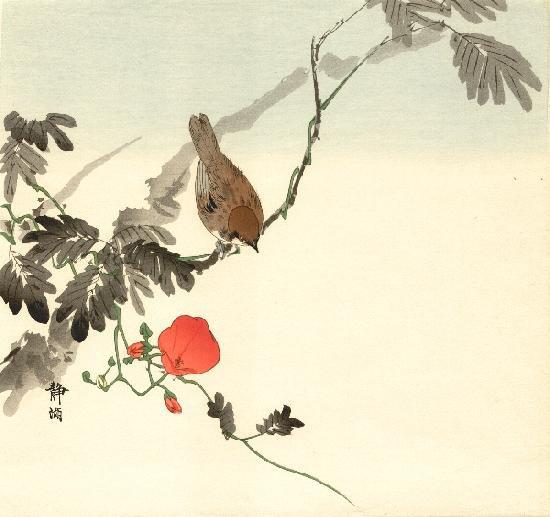
Also, transitions are used in the image of the water surface, the sky. A smooth transition from sunset to dark, thickening twilight looks very nice. In drawing clouds, also use transitions from different shades and reflexes.
The main motives of Japanese painting
In art, everything is interconnected with real life, with feelings and emotions of those involved in it. As in the literature, music and other manifestations of creativity, there are several eternal topics in painting. These are historical stories, images of people and nature. 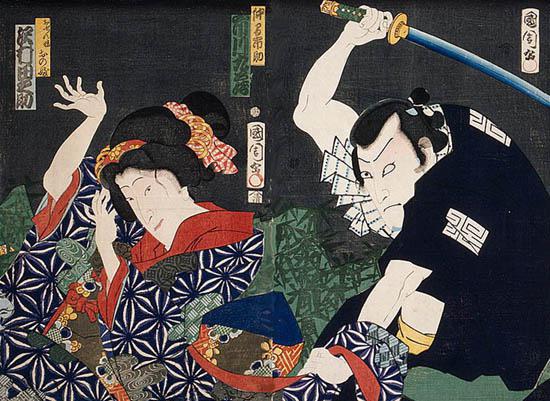
Japanese landscapes are diverse. Often in the pictures there are images of ponds - a favorite interior of the Japanese interior. Several water lilies and bamboo not far away - this is how the usual picture of the 17-18th century looks like.
Animals in Japanese painting
Animals are also a frequently repeated element of Asian painting. Traditionally, this is a crumpled tiger or a domestic cat. In general, Asians love themselves very much and therefore their representatives are found in all forms of oriental art. 
The Fauna World is another topic that Japanese painting follows. Birds - cranes, decorative parrots, luxurious peacocks, swallows, imperceptible sparrows and even roosters - they are all found in the drawings of oriental masters.
Fish - no less relevant theme for Japanese artists. Koi carps are a Japanese version of the Golden Fish. These creatures live in Asia in all ponds of even small parks and gardens. Karp Koi is a kind of tradition belonging to Japan. These fish symbolize the struggle, determination, achieving their goal. Not in vain, they are depicted by floating overstream, be sure to decorative crests of the waves.
Japanese paintings: image of people
People in Japanese painting are a special topic. Artists depicted geish, emperors, warriors and elders.
Geisha is drawn surrounded by flowers, always in complex robes with multiple folds and elements.
The wise men draw sitting or explaining something to their disciples. The image of an old scientist is a symbol of history, culture and philosophy of Asia.
The warrior was portrayed formidable, sometimes awesome. Long hair The samurai was drawn in detail and looked like a wire.
Usually all the details of the armor are refined using a carcass. Often, naked warrior decorate tattoos with the image of the Eastern Dragon. This is a symbol of strength and military power of Japan.
Rulers were depicted for imperial families. Beautiful apparels, decorations in the hair of men - what such works of art is replete.
Landscapes
Traditional Japanese landscape - Mountains. Asian painters succeeded in the image of a variety of landscapes: the same top they can portray in different colors, with a different atmosphere. The only thing remains unchanged is the mandatory presence of colors. Usually, along with the mountains, the artist depicts some kind of plant in the foreground and draws it in detail. Beautifully looking paintings with the image of mountains and flowering sakura. And if you draw fallen petals - the picture causes admiration for sad beauty. The contrast in the picture atmosphere is another remarkable quality of Japanese culture. 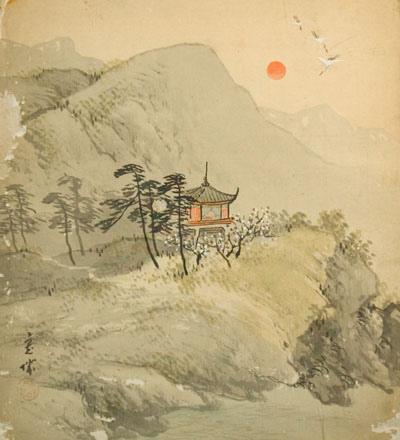
Hieroglyphs
Often the composition of the painting in Japanese painting is combined with letters. The hieroglyphs have so that it looked beautifully composite. Usually they draw to the left or right of the picture. The hieroglyphs may indicate what is shown in the picture, its name or the name of the artist.
Japan is one of the richest history and culture of powers. All over the world, it is customary to consider the Japanese with pedantic people who find aesthetics absolutely in all manifestations of life. Therefore, the Japanese paintings are always very harmonious in color and tone: if there is some bright color splashing - then only in semantic centers. On the example of paintings by Asian artists, color theory can be studied, the correct transmission of the shape with the help of graphics, composition. The technique of execution of Japanese paintings is so high, which can serve as an example of working with watercolor and the implementation of "laundering" of graphic works.
When creating an interior in an apartment or office, as a rule, the task is to provide comfort, heat and an environment that promotes work. To solve this task, and creating a beautiful and aesthetic interior indoor, the latest and classic design motives are used. Some design elements include pictures in japanese style. IN lately This direction of painting is more often used when decorating the interior. We will describe in detail that they are paintings in Japanese-style in the interior of apartments, offices and work offices, as well as where to acquire such masterpieces of art.
What is a Japanese painting painting.
Japanese painting paintings are an ancient direction in art. The direction arose in the times of the most ancient historical period of Japan. Images of geometric shapes and patterns that are applied to modern canvases were found on household objects - bowls, jugs, vases. After Chinese cultural values \u200b\u200bbegan to appear in Japan, the masters wondered to create pictures where beautiful Japanese motives were depicted. It is worth saying that in ancient Japan, the paintings on the Japanese theme were popular among the inhabitants of the country, since art masterpieces portrayed landscapes. The main for artists from Japan was the transfer of the greatness of the state. If buying Japanese landscape paintings - today, you get many advantages, as they have a number of features:
In demand among our compatriots use - modular paintings, but all with the same Japanese directions. People who have to contemplate the Masterpiece of Art in Japanese-style, composed of parts, will be able to appreciate the taste of a person engaged in creating comfort in the room.
Where to buy Japanese paintings - landscapes.
We offer our customers the purchase of modular paintings by Japanese themes. Painting is popular among visitors to the store - the Japanese house in Sakura's garden, transmitting the greatness of the country of the rising sun. A Japanese-style picture, which can be used by an inexpensive price, will complement the interior of the Japanese culture, and will add aesthetics. Modular picture Japan and Japanese style is the ability to highlight spirituality and atmosphere in the interior of residential or work room.
Japanese painting is a popular traditional view of Japanese art, which is divided into many genres and styles.
Japanese-style painting
Nature's motives have found the greatest spread in painting in Japanese style. Also in the paintings of the rising sun, various scenes were often depicted from everyday life, samurai, mythological heroes.
The most famous genres of Japanese paintings
Japanese painting technique uki
In the 14th century, the style of Uki-Yo, which included engravings on a tree, on which the life of beautiful geish, actors of the Kabuki Theater, Sumo Fighters and various natural landscapes were shown.
In the process of creating Engraving Ukiyo, the artist, a carver and the press and the whole process consisted of several stages participated. Initially, the painter drew a picture on white paper, then the cutter put the glue on the opposite direction and attached it to a wooden board. When the drawing was glued, parts were cut out of it, which were not painted, thus obtained a printed form. Then the black and white prints were made, the painter attached the necessary colors. The carver made the desired number (up to several tens) printed forms that were combined with a given background or color. Printed after discussion with the artist of the color gamut covered the shape of paint and, applying them to a slightly damp rice paper, created a engraving.
The style in which the Japanese engraving was printed was popular not only in Japan, but also among artists of Western countries, such as Vincent Van Gogh, Claude Monet and others. This impact on European art is called "Japan".
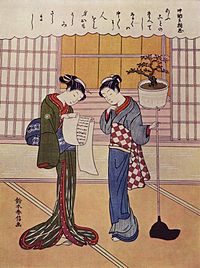
School of Japanese Monochrome Painting Kano
The most famous Japanese school visual arts is a kano school, the paintings of which were portrayed various birds, animals, mythological beings, Cases from the life of ordinary people. The drawings also applied to the sliding doors of Japanese palaces.

Painting Kano.
Artists of the School Kano, to all of the time, are famous for their magnificent monochrome paintings on Sheocha. A distinctive feature of such creations are combinations of real objects and animals that are in the foreground of the image, with abstract, absolutely distracted components of the rear background (for example, clouds).
In modern Japan, there lives a large number of artists who draw in the style of subculture anime and other spheres of the new Japanese culture. Big recognition received Takashi Muroka, working in the studio of Caiika Kiki. He draws pictures dedicated to the life of a post-war Japanese state and anime, in addition, creates sculptures and paintings in surrealistic style and in traditional national genres.
![]()
Japan's painting video
Over the centuries, painting occupied an important place in the culture of the country of the rising sun. About this type of art and will be discussed in the video.
Article genre - Painting of Japan
Japan's monochrome painting is one of the unique phenomena of the art of the East. She dedicated to a lot of work and research, but often it is perceived as a very conditional thing, and sometimes even decorative. This is not the so-worthwhile world of the Japanese artist is very rich, and he takes care not so much about the aesthetic component, how much about spiritual. Art historian is the synthesis of external and internal, explicit and implicit.
In this post, I would like to pay attention not to the history of monochrome painting, but its essence. This will be discussed.
shirma "Pines" Hasegawa Tikhaku, 1593g.
What we see on monochrome paintings is the result of the interaction of the artist Pine Triada: paper, brush, mascara. Therefore, in order to correctly understand the work, you need to understand the artist myself and its attitude.
"Landscape" Sassu, 1398g.
Paper For the Japanese master, not just a girlfriend, which he subordinates his whim, and rather, on the contrary, it is "fellow", therefore, the attitude towards it has developed. Paper is part of the environment, to which the Japanese always treated tremble and tried not to subordinate to themselves, but peacefully coexist with her. Paper is a tree that stood in a certain area, a certain time, "saw" something around him, and she keeps it all. So the material perceives the Japanese artist. Often the masters before starting the job, they looked at the clean sheet for a long time (contemplated it) and only then kiwood began. Even now modern Japanese artists who are engaged in Nihon-Ga (traditional Japanese painting) carefully choose paper. They buy it under the order on paper factories. For each artist of a certain thickness, moisture permeability and invoices (many artists even conclude an agreement with the owner of the factory not to sell this paper to other artists) - therefore, each picture is perceived as something unique and alive.
"Reading in the bamboo grove" Subun, 1446g.
Speaking of the significance of this material, it is worth mentioning such well-known monuments of the literature of Japan as "notes from the head of Sayny Syunagon and" Genji Monochtari "Murassaki Sikibu: both in the" notes ", and in the" Genzi "you can meet plots when court or lovers exchange messages . The paper on which these messages were written was the corresponding time of the year, the shade, and the manner of writing the text corresponded to its texture.
"Marassaki Sikibu in the temple of Iciim" Kesen
Brush - The second component, this is the continuation of the hand of the master (again - this is natural material). Therefore, the brushes were also made to order, but most often the artist himself. He selected the hairs of the required length, chose the size of the brush and the most convenient handle. The master writes only his brush and no other. (From personal experience: was on the master class of the Chinese artist Jiang Shilun, the audience asked to show that his students who were present at the master class, and each of them, taking a brush of the master, said that it would not be what they would expect Since the brush is not them, they are not accustomed to her and do not know how to use it).
Fuji Sketch Katsusik Hokusai
Mascara - the third important element. Mascara happens different species: It can give a glossy or matte effect after drying, maybe with an admixture of silver or oath shades, so right choice Masca is also not small.
Yamamoto Baitz, end of the XVIII - XIX century.
The main plots of monochrome painting are landscapes. Why is there no color in them?
Steam shirma "Pines", Hasegawa Tikhaku
First, the Japanese artist is not interested in the subject itself, and its essence, a certain component, which is common to all living things and leads to human harmony. Therefore, the image is always a hint, it is addressed to our feelings, and not to sight. In obviousness is the incentive of dialogue, which means the compounds. In the image, lines and stains are important - they form the artistic language. This is not a master's liberty, which where wanted, left a fat footprint there, and elsewhere, on the contrary, was undersonated - everything has its meaning and meaning, and does not carry a random nature.
Secondly, the color always carries some emotional color and perceived differently different people in different states, Therefore, emotional neutrality allows the viewer to join the dialogue most adequately, to arrange it to perception, contemplation, thoughts.
Thirdly, this is the interaction of Yin and Yang, any monochrome picture Harmonious from the point of view of the ratio of carcass and untouched paper areas.
Why most of the paper space is not involved?
"Landscape" Subun, middle of the XV century.
First, the openness of the space is dipping a visitor to the image; Secondly, the image is created as if it fell on the surface for a moment and is about to disappear - this is due to the worldview and worldview; Thirdly, on those areas where there is no carcass to the fore. The texture and shade of paper (on the reproductions it is not always visible, but in fact it is always the interaction of two materials - paper and carcass).
SESSU, 1446
Why landscape?
"Contemplation of waterfall" Gayami, 1478g.
According to the Japanese worldview, the nature of the person is perfect, so he must learn from her, in every way to protect it, and not destroy or subordinate. Therefore, many landscapes can see small images of people, but they are always insignificant, small in relation to the scenery itself, or images of huts that are inscribed in their space and are not always noticeable - these are all symbols of the worldview.




